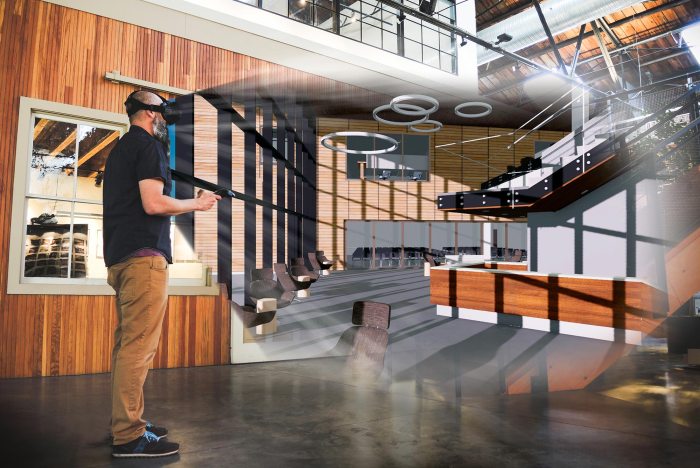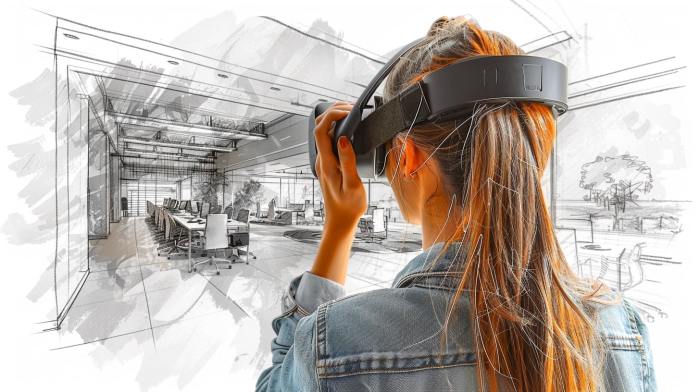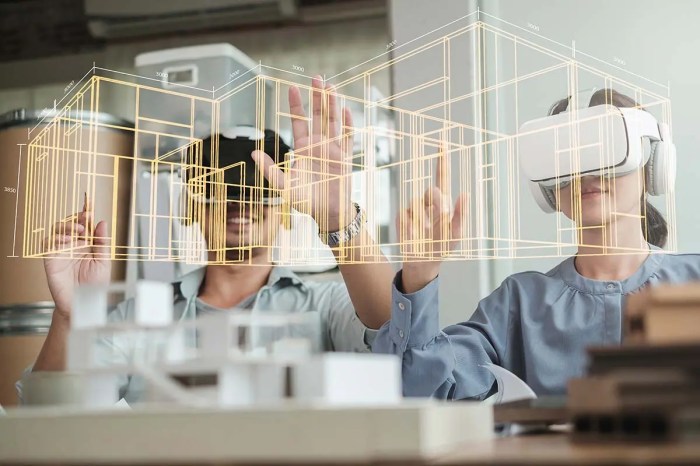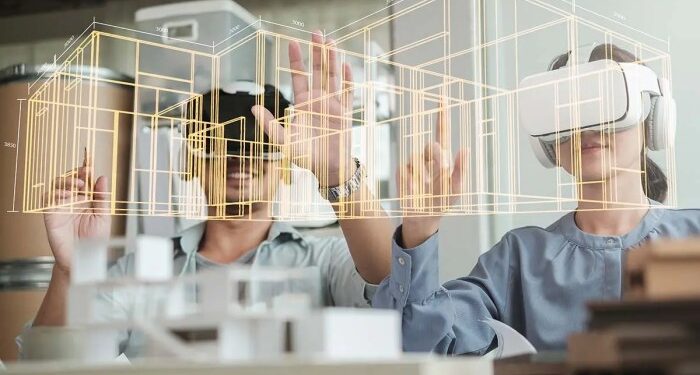Embark on a journey through the innovative world of VR architecture, where virtual reality technology meets traditional architectural practices to create immersive and groundbreaking experiences. From design principles to tools and software, uncover the key components that shape the future of architectural design.
Understanding VR Architecture

Virtual Reality (VR) architecture refers to the use of virtual reality technology in the field of architecture to create immersive and interactive experiences for design, visualization, and presentation purposes. By utilizing VR headsets and software, architects and designers can explore their creations in a realistic 3D environment, allowing for better understanding and communication of design concepts.
Key Components of VR Architecture
- VR Headsets: Devices used to immerse users in a virtual environment.
- VR Software: Programs that enable the creation and interaction with virtual architectural models.
- 3D Modeling: Creating detailed 3D models of architectural designs for VR visualization.
- Interactivity: Allowing users to navigate and interact with virtual spaces in real-time.
Differences from Traditional Architectural Practices
- Real-time Visualization: VR architecture provides instant feedback on design decisions, unlike traditional 2D drawings.
- Immersive Experience: Users can experience a design as if they were physically present within it, enhancing understanding and engagement.
- Collaboration: Multiple stakeholders can interact in the same virtual space, facilitating better communication and decision-making.
Examples of VR Architecture Applications
- Real Estate: Virtual tours of properties allow potential buyers to explore homes without physically visiting them.
- Urban Planning: City planners can visualize and analyze urban developments before implementation.
- Interior Design: Clients can experience different interior layouts and styles before making final decisions.
Design Principles in VR Architecture

In VR architecture, the design principles play a crucial role in creating immersive experiences that engage users in a virtual environment. Let's delve into the key principles that architects and designers must consider when crafting VR architectural experiences.
Design Considerations for Physical vs. VR Architecture
- Physical Architecture: Focuses on structural integrity, materials, and functionality in the real world.
- VR Architecture: Emphasizes creating a digital environment that replicates real-world spaces while offering interactive and immersive experiences.
- Contrast: While physical architecture is limited by real-world constraints, VR architecture allows for limitless creativity and exploration of spatial design.
User Experience Enhancement through Thoughtful Design
- Consideration of Scale: Ensuring that objects and spaces are proportionate to create a sense of presence and immersion for the user.
- Interactive Elements: Incorporating interactive features like navigation, object manipulation, and dynamic lighting to enhance user engagement.
- Attention to Detail: Focusing on intricate details such as textures, lighting, and sound to create a realistic and captivating virtual environment.
Best Practices for Designing Spatial Layouts
- User-Centered Design: Prioritizing user comfort, ease of navigation, and intuitive interactions to enhance the overall experience.
- Optimization of Performance: Balancing visual quality with performance considerations to ensure smooth rendering and minimal lag in VR environments.
- Iterative Design Process: Testing and refining spatial layouts through user feedback to optimize usability and engagement.
Tools and Software for VR Architecture
Virtual reality (VR) technology has revolutionized the field of architecture by providing immersive experiences for designers and clients alike. Utilizing the right tools and software can greatly enhance the architectural design process and streamline workflow efficiency
Popular Tools and Software
- Unity: A versatile platform that allows architects to create interactive 3D environments and visualize their designs in VR.
- Unreal Engine: Known for its high-quality graphics, Unreal Engine enables architects to develop realistic virtual environments for design exploration.
- SketchUp: Ideal for creating 3D models and architectural designs, SketchUp offers plugins for VR compatibility, allowing for easy integration of VR technology.
- Revit: Widely used in the architectural industry, Revit offers tools for Building Information Modeling (BIM) and supports VR experiences to enhance design collaboration.
Streamlining Workflow
These tools enable architects to visualize and manipulate designs in real-time, facilitating quick decision-making and design iteration.
Using VR technology in architecture software enhances communication between stakeholders, leading to more efficient project management and better design outcomes.
Importance of Integration
- Enhanced Visualization: VR technology provides a more immersive and realistic representation of architectural designs, allowing for better understanding and decision-making.
- Client Engagement: Integrating VR into architectural software enhances client presentations and helps in conveying design concepts effectively.
Impact on Efficiency
VR tools reduce the need for physical models and renderings, saving time and resources in the design process.
Architects can collaborate remotely, conduct virtual walkthroughs, and make real-time design changes, leading to faster project timelines and improved design quality.
Challenges and Opportunities in VR Architecture

The integration of VR technology in architecture brings about both challenges and opportunities for architects and designers. Let's explore some of the key aspects in this field.
Challenges Faced by Architects and Designers
- Complexity of Technology: Implementing VR technology requires specialized skills and knowledge, which can be a barrier for architects and designers.
- Cost and Resources: Setting up VR infrastructure and acquiring the necessary software and hardware can be expensive, especially for smaller firms.
- User Experience Design: Ensuring a seamless and intuitive user experience in VR environments poses a challenge, as it requires a deep understanding of human-computer interaction.
Opportunities in VR Architecture
- Innovative Design Exploration: VR technology allows architects to visualize and experience designs in a way that was not possible before, leading to more innovative and creative solutions.
- Collaborative Design Process: VR enables real-time collaboration between team members and clients, enhancing communication and speeding up the design iteration process.
- Virtual Site Visits: VR can simulate real-world environments, enabling architects to explore and assess sites remotely, reducing the need for physical travel and minimizing carbon footprint.
Addressing Sustainability and Environmental Concerns
- Energy Efficiency Simulation: VR can be used to simulate and analyze the energy performance of buildings, helping architects design more sustainable and energy-efficient structures.
- Material Selection and Lifecycle Analysis: Virtual reality tools can assist in evaluating the environmental impact of materials used in construction, promoting the selection of eco-friendly options.
Successful Projects Leveraging VR Technology
- Virtual Reality Museum Tours: Museums around the world have adopted VR technology to offer immersive virtual tours, enhancing the visitor experience and accessibility.
- Architectural Visualization for Clients: Many architecture firms use VR to create realistic visualizations of projects for clients, allowing them to explore and understand the design before construction begins.
Closing Summary
In conclusion, VR architecture opens up a realm of possibilities for architects and designers to push boundaries, enhance user experiences, and address sustainability concerns. As technology continues to evolve, the fusion of virtual reality and architecture will undoubtedly lead to exciting innovations and creative solutions in the field.
Questions Often Asked
What are the key components of VR architecture?
Key components of VR architecture include immersive visualizations, interactive environments, and real-time collaboration tools.
How does VR architecture enhance user experience?
VR architecture enhances user experience by providing immersive and interactive environments that allow users to experience spaces before they are built.
What are some popular tools used in VR architecture design?
Popular tools in VR architecture design include Unity, Unreal Engine, Autodesk Revit, and SketchUp.
Can VR architecture address sustainability concerns in design?
VR architecture can address sustainability concerns by allowing architects to visualize and optimize energy-efficient designs before construction.












